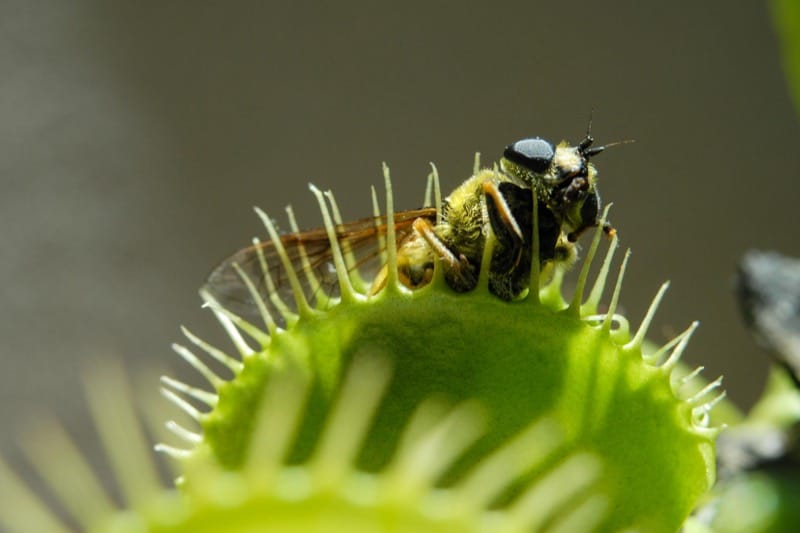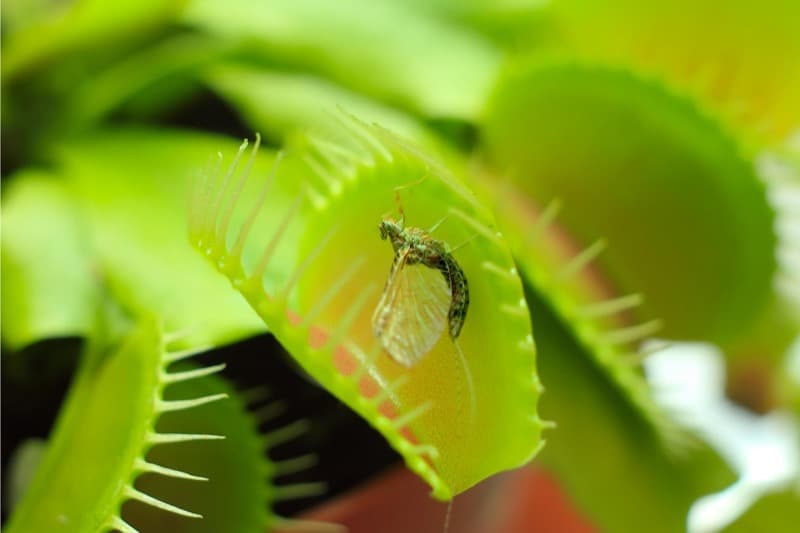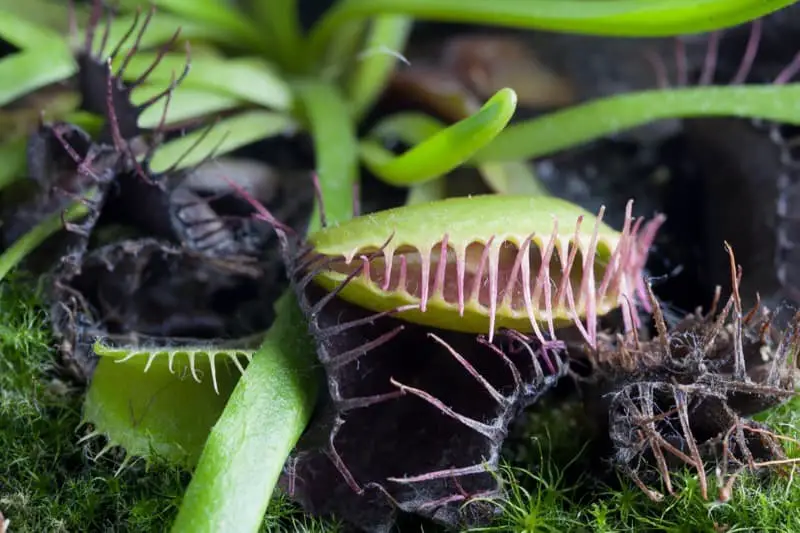It’s not enough to just buy a Venus flytrap plant. You also need to feed it properly. In this article, I’ll share with you the best Venus Flytrap food for healthy growth.
Venus Flytraps live in nutrient-poor soil, especially in its native habitat along the North Carolina and South Carolina coasts. Since the soil doesn’t give them the nutrients they need, Venus Flytrap plant food is any insect they can catch in their traps.
Do Venus fly traps eat crickets? Yep, they sure do!
If you’re growing a Venus Flytrap as an indoor potted plant, you’ll need to provide the insects for the feeding process. It’s important, however, that you supply your Venus Flytrap with appropriate insects, as not all insects will be suitable.

What Does a Venus Flytrap Eat?
It’s important, that you supply your Venus Flytrap with appropriate insects, as not all insects will be suitable.
These are the best Venus Fly trap food options and types of insects for key nutrients:
1. Crickets
Venus Flytraps love dried crickets if you can find ones that are small enough. Crickets are highly nutritional and provide calcium, fat, zinc, potassium, copper, magnesium, and iron as well as mineral, vitamins, and fiber.
How can Venus fly traps eat crickets?
When inserting one into the trap, make sure that the antennae do not stick out as this will prevent the complete sealing of the trap during digestion.
2. Bloodworms
Bloodworms provide a polymer known as chitlin, that will activate the Venus Flytrap’s immune system and defenses. They are also a good source of vitamin B-12, niacin, amino acids, vitamin C, beta-carotene, and riboflavin.
Bloodworms are found for purchase in pet or aquarium supply stores because they are generally used as fish bait. They are small worms that have been freeze dried and will need to be rehydrated with a few drops of distilled water before you feed them.
Slice your bloodworms into appropriately sized pieces if they are too large for the trap. Cut them down to about 1/3 of the size of a single trap.
3. Flies
Flies are a good source of nutrients because they are packed with magnesium, calcium, and iron, Venus Flytraps will consume flies all the time, both indoors and outdoors.
Venus Flytraps attract flies with sweet nectar produced inside the lobes.
4. Mealworms
Mealworms are a great option because they are rich in protein, amino acids, and vitamins. These tiny worms are the larval form of mealworm beetles and are great, nutrition-wise for your plant.
Their nutritional value is on a par with that of fish. They also provide omega-3 fatty acids and monosaturated fats.
Mealworms, like bloodworms, are sold in pet stores as small, freeze-dried worms. They may be too big for some traps, so you can cut the bug into several smaller pieces. You will also need to rehydrate these bugs before feeding them.
Learn more about Venus Flytraps Eating Mealworms.
5. Spiders
Spiders are a nutritious source of Venus flytrap food due to the amount of protein they provide. They are also a great source of zinc and folic acid. Spiders can provide a substantial part of the platn’s insect diet.
Interestingly, many spiders are carnivorous, like the Venus Flytrap, and will inject digestive fluids into their prey and suck up the liquefied insect. If the spider wanders into a trap, that’s how they end up as prey as well.
6. Fruit Flies
These tiny insects are perfect prey for flytraps. Fruit flies are easy to trap, digest, and provide the vital nutrients the plant craves. So yes, Venus flytraps do eat fruit flies.
7. Mosquitoes
Do Venus Flytraps eat mosquitoes? You bet!
Mosquitoes provide essential nutrients. Nitrogen and phosphorous, primarily. These nutrients, scarce in the plant’s natural habitat, are critical for its growth and development.
Other suitable food options for your Venus Flytrap plant include:
- Ants
- Beetles
- Fish pellets
- Gnats
- Grasshoppers
- Mosquitoes

Dead vs. Live Feed
Dead insects are equally as suitable for Venus Flytrap feeding as live insects are. It doesn’t matter if the insect is dead or alive, as both will offer the same nutritional value to your plant.
However, feeding dead insects can present somewhat of a challenge because you’ll need to present the dead feed as live feed to the traps.
Feeding a dead bug will be less natural than your plant attracting a live insect. You will need to do a couple of extra steps if you want to feed dead insects, such as rehydrating the insect.
Some live feed can also present a problem. For example, mealworms may attempt to burrow out of a trap when fed while alive. However, you can stun live insects by placing them in the freezer for several minutes before feeding them to your plant. This will help prevent live insects from being very active.
You can usually find a supply of dead bugs in your yard or garden or home, or you can buy insects in pet and aquarium supply stores. Some pet stores will also sell live bugs or the traditional freeze-dried version of selected insects.
You’ll also generally find fruit flies, bloodworms, mealworms, or crickets available for sale easily online, like on Amazon.
What Food to Avoid for a Venus Flytrap
Even though there is a lot of insect food for Venus Fly traps, several insects are not suitable and should be avoided.
These are bugs that you should avoid feeding a Venus Flytrap include:
1. Caterpillars
A Venus Flytrap can theoretically consume a caterpillar, but if the caterpillar is sufficiently strong and quick, it can and will attempt to eat its way out of the trap. If the caterpillar’s escape is successful, it may decide to continue eating and consume the entire plant.
2. Slugs
Slugs present the same problems as caterpillars. If the slugs are strong and desperate, they may eat their way out.
3. Snails
Snails cannot be used because of their shells which the Venus Flytrap will not be able to digest. They are also generally too large for the traps.
How to Feed Your Venus Flytrap
Feeding your Venus Flytrap can be a fun activity, especially for kids. But do make sure you follow the proper feeding method. Avoid improvising when feeding your plant. If you feed it incorrectly, you may end up involuntarily damaging your flytrap.
Venus Flytrap plants cultivated outdoors will capture their prey naturally. Outdoor flytraps do not require supplemental feeding as they have constant access to live insects.
Plants cultivated indoors may occasionally capture a lone housefly, but it’ll most likely not have many chances to feed, so you’ll need to help feed them.
They don’t require large quantities of insects for health or survival purposes, but occasional feeding will benefit your plant. The feeding process is pretty easy.
Follow these tips to successfully feed bugs to your Venus Flytrap.
- Only use very small bugs that should measure no more than 1/3 the size of the trap that you are feeding.
- When feeding your Venus Flytrap, only feed one trap per plant each time.
- Feed your Venus Flytrap a single bug every 2 to 4 weeks. That’s about how long it will take the trap to fully digest the food.
- Do not feed your plants during the winter dormancy period. They don’t need to feed when dormant.
Learn more about Venus Flytraps During Dormancy.
Feeding a Live Insect
Here are the steps to feeding a live insect to a Venus Flytrap.
Step 1: Pick Your Bug
Select a bug among the insects that are appropriate for Venus Flytrap consummation. It should have a high nutritional value and be the correct size for the trap you are feeding.
The bug size should be no larger than 1/3 the size of the trap you’re feeding.
Step 2: Find the Trap’s Trigger Hairs
Each trap leaf will have three trigger hairs that are filaments found on the inside of the lobe. They are signals to the trap that something is inside the trap, and triggering the trap to close.
Step 3: Get the Insect
Using a pair of tweezers, pick up the insect.
Step 3a for Freeze-Dried Bugs: Rehydrate the Bug
If you are using a dead insect, it will need to be rehydrated. Put a few drops of distilled water onto the dead bug and wait until it absorbs the water.
Step 4: Position the Bug
Position the bug you have selected inside the center of the Venus Flytrap lobes.
Step 5: Trigger the Trap
Brush or touch the trigger hairs within the trap twice. Once the trigger hairs have been touched two times within twenty seconds, the trap should close around the insect.
Step 6: Observe the Trap
Wait several minutes to verify the trap is fully closed. The Venus Flytrap will immediately begin producing digestive enzymes to digest the bug.
Remember that the trap will not reopen for several days and may even remain closed for several weeks until digestion is completed.
When the Flytrap reopens, it will be ready to catch new prey. After a about five closings and openings, a trap will exhaust its energy and cease to close. Should a trap no longer close, it is not necessarily an indication of health issues, but part of the natural life cycle of a trap.
Read more about Venus Fly Trap Opening and Closing.

Troubleshooting Venus Fly Trap Feeding
Occasionally after a feeding, the plant’s foliage may turn black. When leaves are old, they will begin to blacken along the edges, eventually wilting, and will turn black. Improper feeding can cause leaves to blacken. Feeding during dormancy can cause leaves to blacken.
- Related article: Why Venus Flytraps Turn Black
If insects are too large for the trap, that will lead to overfeeding your Venus Flytrap and an inability to digest the food. If the bug is too large, a plant may decide to let the trap to die so that it saves energy.
By selecting a properly sized insect, only feeding one bug at a time, and not disturbing your plant during its dormancy, you should prevent leaves from turning black, unless their natural life cycle is finished.
- Related article: Venus Flytrap Feeding Frequency
Can a Venus Flytrap Eat Things Other than Insects?
They are capable of digesting meat that comes from tiny rodents, birds, or frogs, but this is rare. The pieces they eat will need to be really small because Venus Flytraps don’t grow that big.
In their native habitat, their diet will mostly contain bugs. Avoid attempting to feed your plant anything other than bugs or spiders, as they will most likely experience difficulty in digesting the entire insect and the trap may begin to rot.
Can Venus Flytraps Eat Human Food?
Human food is not suitable for these plants or any type of carnivorous plant. This food is too complex for their digestion. If they are unsuccessful when digesting, traps will begin to wither, and the food inside will begin to rot, developing both bacteria and mold.
How Long Can a Venus Flytrap Live Without Food?
Venus Flytraps can survive a month without an insect. The flytrap remains healthy, its growth largely unaffected. Push this timeline, and you’ll notice changes. Slowed growth. Diminished vibrancy.
Venus flytraps are masters of adaptation. They thrive in nutrient-poor soils by trapping insects for sustenance. But food isn’t their sole lifeline.
Photosynthesis is their primary source of nourishment. Sunlight, water, and carbon dioxide keep them thriving. Insects? They’re the bonus meal, providing scarce nutrients like nitrogen.
However, this timeline shortens in low light conditions. Here, the flytrap leans more heavily on insects. Without them, survival becomes a tough battle.
Yet, the Venus flytrap diet is a delicate balance. Overfeeding these green predators is harmful. Best practice? Allow them to catch their own meals.
Still, there’s variability in these timelines. Size, age, and overall health dictate survival. The environment plays a crucial role too.
So, here’s the takeaway. Optimal care is paramount. It’s the secret to a healthy, long-lived Venus flytrap.
Venus Fly Trap Food Final Thoughts
The best way to care for your Venus Flytrap is to provide them with healthy, nutritious foods. They like to eat things like crickets, mealworms, flies, and other small bugs.
Learn more about Venus Flytrap care with these articles:




